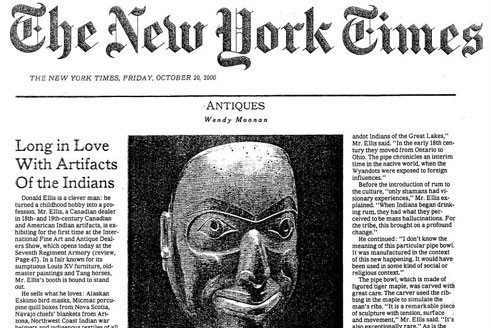
Donald Ellis and Historical Native American Art
The New York Times
On the occasion of his first participation in the International Fine Art and Antique Dealers Show, a featured article in the New York Times discusses Donald Ellis's conviction to present historical Native American artifacts as works of art. ’The appeal of these unusual and handsome objects is obvious,’ Wendy Moonan writes. ‘And although they are expensive, the prices are a fraction of those fetched by 20th century sculpture.’
Ellis turned a childhood fascination into his profession. ’You couldn’t learn about this at school when I was growing up,’ he explains. Collecting his first pottery shards and arrowheads while living near the Grand River on the edge of the Six Nations Reserve in Brantfort, Ontario, at the age of 7, Ellis started dealing with Native American Art at 15, while he was still in school. However, it was not until 1976 that he set up his own business. Today, he deals exclusively with historical Native American art, including Yup’ik dance masks from Alaska, Micmac porcupine quill boxes from Nova Scotia, war helmets from the Northwest Coast and Navajo chiefs’ blankets from Arizona.
Rather than tapping into the existing ethnographic world, Ellis decided to highlight the best Indigenous works as art. ‘I like things with strong visual appeal,’ he is quoted. In doing so, Moonan writes, ‘he is following a tradition begun by Picasso and other early 20th century artists,’ on whose artistic practices Indigenous art has had profound influence.
Many of his clients are major collectors of 20th century art, perhaps because ’masks and objects used in rituals and day-to-day life are like sculpture,’ Ellis says. He has also sold a number of works to major art museums, including the Cleveland Museum of Art and the Museum of Fine Arts in Boston.
Among the rarest works presented at the International Fine Art and Antique Dealers Show is a pipe carved in the form of a human figure drinking from a rum keg, likely made by the Wyandot people of the Eastern Woodlands. Carved from tiger maple, the artist used the ribbing in the wood to accentuate the man’s ribs. Created in the early 18th century, ‘it is a remarkable piece of sculpture with tension, surface and movement,’ Ellis explains.
‘It’s all in how you define art,’ the author closes. ‘These artifacts are not merely aesthetically pleasing. They are also laden with intention and purpose.’
Download Donald Ellis and Historical Native American Art Clipping
